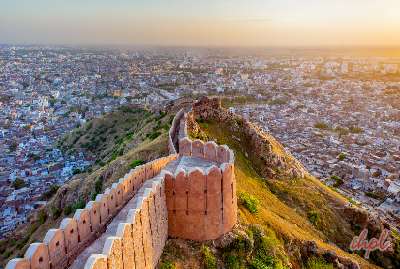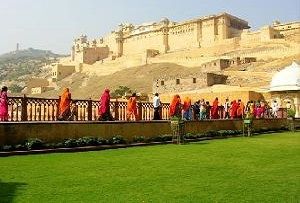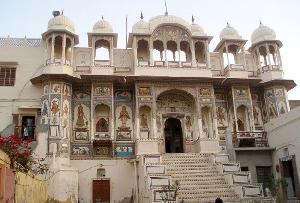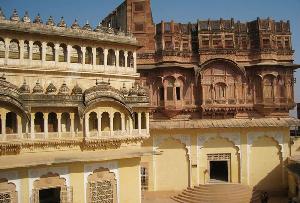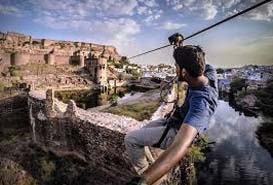Radha Murlimanohar Temple is located in Laxmangarh which is a town in Sikar district of Rajasthan in India. Laxmangarh is dotted with many attractive tourist spots such as Laxmangarh fort, the Ghanta ghar or the Clock Tower and various havelis adorned with Shekhawati fresco paintings that are the hallmark of the town. It is also visited for the famous Radha Murlimanohar Temple. If you wish to pay a visit to Radha Murlimanohar Temple, Laxmangarh, you have to head for Char Chowk Haveli on reaching Laxmangarh. About 50 m east of this haveli is the huge Radha Murlimanohar Temple, dating back to 1845.
Once you visit the famous Char Chowk haveli you shall see on its northern external wall a picture of a bird standing on an elephant with another elephant in its beak. The big paintings on the facade of the northern face have mostly faded, and the paintings in the outer downstairs courtyard are covered by blue wash. The walls and ceiling of a small upstairs room on the east side of the northern haveli are completely covered with exquisite paintings. The haveli also features explicit erotic images, which you can make out after careful observation.
As you proceed further, a room in the northwest corner showcases floral swirls and motifs on the ceiling with scenes from the Krishna legends adorned with inlaid mirrors. The black and white rectangular designs on the lower walls create a marbled effect. The front portico is in very poor condition at the lower levels, with the plaster crumbling and the bricks exposed. The southern haveli is still inhabited. As you walk further up to 50 m you shall view the huge Laxmangarh Radha Murlimanohar Temple.
Radha Murlimanohar Temple is adorned with a few paintings beneath the caves and some sculptures of deities bounding the external walls. The south side of the temple is the busy bazaar; flanked by a series of uniform shops whose overhanging balconies have three scalloped open arches flanked by two blank arches with lattice friezes. The shops were built in the mid-l9th century by the descendants of the Poddar family known as Ganeriwala, who hailed from the village of Ganeri.
As you turn left at the very first junction south of the Radha MurliManohar temple, on the corner of the first laneway on the left is the Chetram Sanganeeria Haveli. This haveli has close connection to the temple. It showcases different life styles of people at that period of time. Paintings on this wall include a woman in a swing suspended from a tree; a woman spinning; a man dancing on a pole balancing knives; people enjoying a ride on a Ferris wheel; a man ploughing fields with oxen; and men sawing timber.
History of Radha Murli Manohar Temple, Laxmangarh
Radha MurliManohar Temple was founded in 1845 by an eminent Rajput ruler. According to historical facts the town of Laxmangarh was founded by the Rao Raja Laxman Singh of Sikar Thikana planned under Shekhawati region of erstwhile Rajputana.





